One Week in Azerbaijan: The Perfect Azerbaijan Itinerary (original) (raw)
Looking for an easy Azerbaijan itinerary to see the best of the country in one week? This guide pulls together the best things to do in Azerbaijan for first-time visitors. Detailed transportation info, travel tips and up-to-date advice included.
No trip to the South Caucasus region is complete without dipping your toes in Azerbaijan.
More Orient than Occident, it is in many ways a stark contrast to Georgia and Armenia. But just like its neighbours, Azerbaijan is an overwhelmingly safe destination that is easy to travel independently using a combination of public transport and transfers or with a hire car.
Azerbaijan is rich in both nature (alpine hiking, winter skiing) and history and culture (particularly from the Silk Road period). From the ultra-modern capital of Baku to the charming city of Sheki – one of my favourite places in the entire region – Azerbaijan might be lesser-known, but it is no less fascinating.
I have been lucky enough to visit Azerbaijan three times now. I was even invited to speak about the country on the Amateur Traveler podcast. Living in Georgia, I have plans to return soon – there are still so many places I am yet to see.
If you’re looking for an easy add-on to your Georgia itinerary or something more substantial to insert into a broader Caucasus travel itinerary, this Azerbaijan itinerary showcases the best of the country’s north and beyond.
Also see: My recommended Azerbaijan Georgia itinerary (overland travel through the two countries).
Please note: This post contains affiliate links, meaning I may earn a commission if you make a purchase by clicking a link (at no extra cost to you). Learn more.
Azerbaijan itinerary overview & map
Here is a brief outline of the itinerary described in this guide.
Below, you will find a day-by-day breakdown of the route, including things to do, where to stay, and transportation tips for getting from place to place.
Days 1-2: Baku
Day 3: Day trip to Gobustan & the Absheron Peninsula
Days 4-5: Quba & Khinaliq
Day 6: Shamakhi, Lahic, Tufandag & Gabala (overnight in Sheki)
Day 7: Sheki
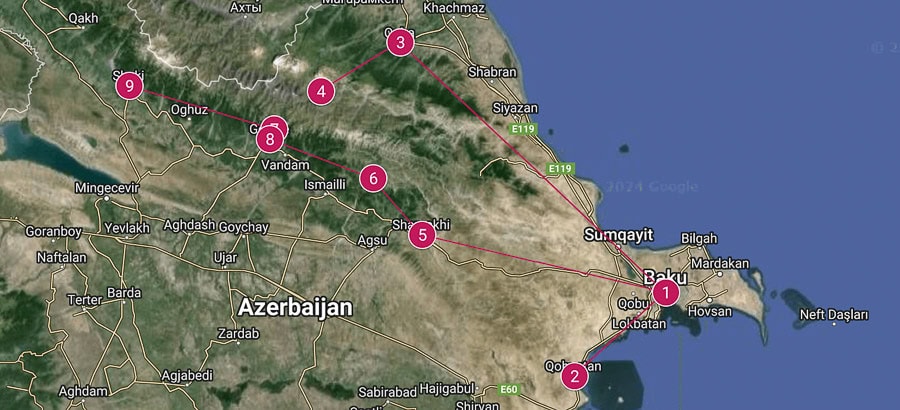
Click here to open the map in Google Maps.
How to plan an Azerbaijan itinerary
First, here are some basic pointers to help with planning your Azerbaijan visit.
When is the best time to visit Azerbaijan?
Spring (late March-May) and autumn (September-October) are the best times to visit Azerbaijan and the Caucasus more broadly. These months bring pleasant temperatures, lighter crowds, and a host of cultural festivities.
In spring (March 20 in 2025), Azerbaijan celebrates the Persian New Year with the Novruz festival. The five-day event includes folk music and dance performances, processions and other rituals around Baku and the entire country.
In autumn (September and October), there are several autumn festivals including the Goychay Pomegranate Festival, the Persimmon Festival in Balakan and the Apple Festival in Quba.
For the past 8 years, Baku has hosted the Grand Prix. In 2025, the race will take place from September 18-21. Keep in mind that the city is very busy during this period, and accommodation prices are inflated. The race takes place right in the centre of the city, and there are road closures that make it a bit trickier to get around.
How many days in Azerbaijan?
I recommend a minimum of 2 days to see Baku, and a minimum of 7 days to see Azerbaijan (the main highlights of the northeast and northwest). With 10 days, you can see more of the country, including Nakhchivan.
This itinerary focuses on northern Azerbaijan and can therefore easily be combined with Georgia and/or Armenia. Keep in mind that the Azerbaijan-Armenia land border is closed, necessitating transit through Georgia.
See below for up-to-date information on entering and exiting Azerbaijan.

Baku, Azerbaijan.
Do you need a visa for Azerbaijan?
Most visitors to Azerbaijan require a visa. Citizens of a dozen countries (including the UAE and Turkiye) do not need a visa.
For everyone else (including citizens of the EU, Australia, the US and the UK), you will need to apply for an e-visa in advance. This electronic system was introduced in 2017 and makes it very easy to get your documents in order.
Visas are valid for a period of 90 days from the start date you specify (meaning you must enter the country within that window), and will cover you for a stay of up to 30 days. Only single-entry visas are available.
The fee is 25 USD, payable by credit card. Standard processing takes 3 days, or you can apply for an expedited visa for an additional fee.
To apply, visit Azerbaijan’s official evisa platform and fill out the form. Note that you will need to provide the address of your first accommodation in Azerbaijan.
In addition, anyone staying in Azerbaijan for more than 15 days must go through an additional step of registering their stay with the State Migration Service. Failure to do so might result in a fine or worse. As your guesthouse to assist you with the process, or register online here.
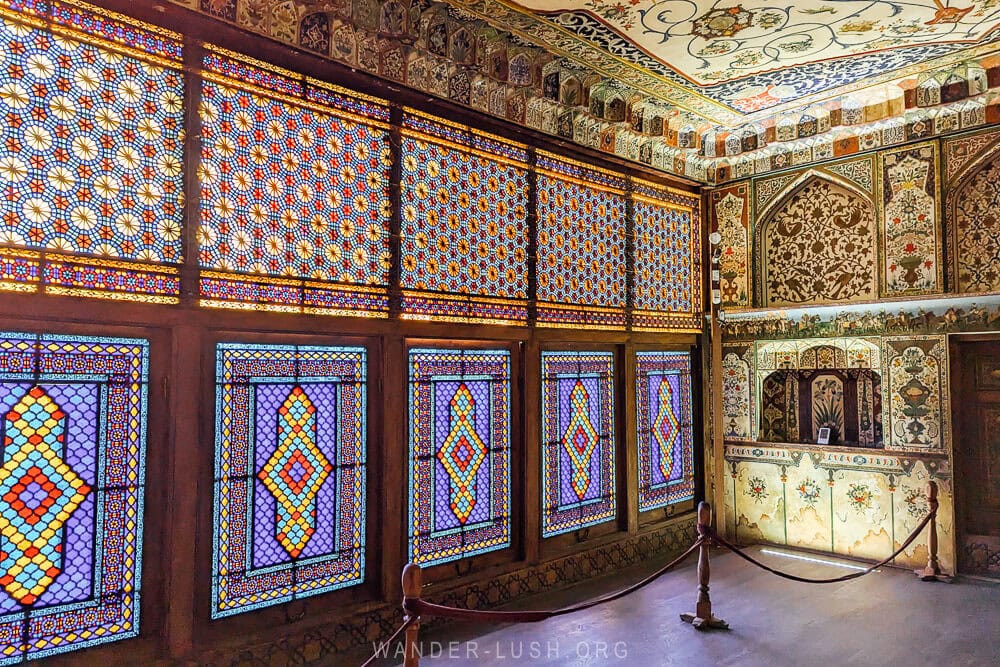
The Khans’ Palace in Sheki.
How to get to Azerbaijan
In 2020, Azerbaijan closed its land borders to inbound travellers. As of 2025, land borders remain sealed – meaning no one can enter Azerbaijan by land. The Tbilisi-Baku night train is on pause and will (probably) relaunch as the Baku-Kars Railway in the coming year.
For now, the only way to enter Azerbaijan is by air. From Tbilisi, there are multiple daily flights with Azerbaijan Airlines (Buta) and Georgian Wings. Additionally, there are direct flights to Baku from Istanbul, Dubai, Doha, and several cities in Europe (London, Rome, Vienna, Barcelona and others).
Foreign passport holders are, however, permitted to exit Azerbaijan overland (by foot only) – meaning you can cross the border back into Georgia. I did this myself in spring 2023.
In light of these restrictions, I recommend starting your Azerbaijan itinerary in Baku and ending in Sheki. From Sheki, you can either cross the land border into Georgia (as I did most recently) or return to Baku to fly out.
How to move around Azerbaijan
Azerbaijan has a railway network and a coach bus/marshrutka system for intercity travel. For Nakhchivan, daily domestic flights are available from Baku.
There are several apps you can use to check transport schedules and reserve tickets. I recommend ADY for trains and Biletim for buses.
If you wish to hire a car and self-drive in Azerbaijan, I recommend using the Local Rent website. The roads in Azerbaijan are generally good – especially the highways. There is a heavy police presence and a lot of cameras, so always stick to the speed limit.
I have included detailed transport instructions – including options for private transfers – in each of the itineraries below.
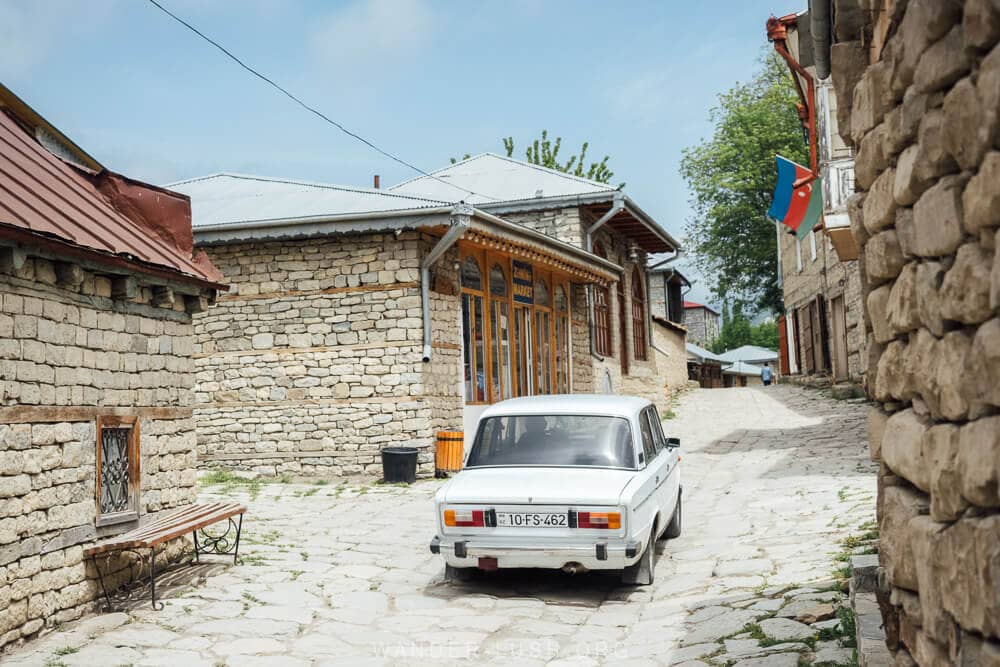
Local transportation in Lahic, Azerbaijan.
Buying a SIM card in Azerbaijan
Obtaining a SIM card in Azerbaijan used to be a very difficult process (back in 2017 when I first visited, it took me a full day to get the job done). Times have thankfully changed. On my recent trip, I bought an Azercell SIM from the shop on the main square. You will need to bring your passport and sign one contract (the process takes around 20 minutes). I paid 30 AZN for a SIM with 30 GB of data (valid for 30 days).
ATMs & money
The currency in Azerbaijan is manat (AZN). Most ATMs in Baku charge a withdrawal fee. We found Pasha Bank (red and green machines) did not incur a fee, and we were able to withdraw a maximum of 500 AZN. Outside of Baku, it is still very much a cash economy, so I do recommend carrying cash with you.
With 7 days in Azerbaijan, you can fit in the best of Baku plus parts of the north of the country. I recommend venturing north-east into the Greater Caucasus mountains first, then heading north-west towards the Georgian border. The city of Sheki is Azerbaijan’s real treasure and the highlight of this itinerary.
This route plan works well as an open-jaw trip. If you are travelling onward to Georgia next, you should plan to cross the land border at Balakan-Lagodekhi to avoid doubling back through Baku. This is exactly what I did on my last trip.
Day 0: Arrival in Baku
To get to your accommodation in Baku from the airport, I recommend using the Airport Express bus. It departs from in front of the arrivals terminal every hour on the hour between 6am and 11pm, and terminates in the city centre outside the 28 May Metro Station.
The fare is 1.30 AZN, and tickets can be purchased from the machine outside the airport hall (cash only).
Alternatively, pre-book a private transfer to your hotel online here. I do not recommend using the Bolt taxi app at the airport as scams are common.
Day 1: The Best of Baku
On your first morning in Baku, wake up early and grab a slice (or a slab) of fresh baklava for a quick breakfast, or enjoy a slow-paced start to the morning at a traditional tea house.
Jump on the metro at Sahil Station and head north-east on the Red Line towards Nariman Narimanov. If you are a fan of underground art, you can take a detour to visit Nizami, Xalglar Doslugu and Elmler Akademiyasi Stations, all of which are embellished with mosaics and other Soviet-era decorations. Just note that photography is strictly prohibited inside the metro (and from personal experience, I can tell you this rule is rigorously enforced!).
The ultra-modern Heydar Aliyev Center is one of Azerbaijan’s most impressive landmarks – and honestly one of my favourite buildings in the world. It is a very evocative piece of architecture and a lot of fun to photograph.

The Heydar Aliyev Centre.
After you have walked a lap around the building and peeked inside, head back towards the city centre on foot, stopping for a look at the Yasil Bazar, Baku’s green market. Jump back on the metro at 28 May Station and ride to Icherisheher to spend your afternoon exploring Baku’s walled Old City.
Find that famous photo spot – where the modern Flame Towers rise up behind the historic facades. For a nice view over Baku, climb the Maiden Tower, and don’t miss my favourite museum, the Underground Bath Museum (Yeralti Hamam), a 17th-century hamam that contains a fascinating exhibition about bathing culture.
You need at least 1.5-2 hours to fully explore the Shirvanshahs Palace and its various mosques, tombs and museum displays. Depending on your timing, you can do this before or after lunch.

Old Baku.
When it’s time to refuel, head to Passage 145 and find a table beneath the arched roof that is painted with charming pictures of Old Baku traders and artisans. Order the Baku salad (a punchy combo of tomatoes, red onion, cornelian cherries and mint) and to finish, a slice of the balli tort honey cake.
At 3pm, join the 2-hour Baku Old Town & Oil Heritage Walking Tour hosted by Azerbaijan Traveller. If you’re lucky, you will meet the exceptional guide Gani Nasirov. This walk will give you a lay of the land and some much-needed local insights to start making sense of the hodgepodge that is Baku beyond what you have already seen.
An hour or so before sunset, hitch a ride on the Baku Funicular to Highland Park. Walk Martyrs’ Lane and visit the Shahidlar Monument before staking out a position at the viewpoint for a panoramic view of Baku city and the Caspian Sea at golden hour.
Descend the stairs and take a stroll along the Bulvar promenade, which is beautiful at twilight, before heading to Dolma Restaurant for dinner. I recommend the house special dolma and the pumpkin plov.
If you have the energy, head to ETUD for a Mugham jazz session, or to KEFLI for a quiet glass of Azerbaijani wine.
Recommended reading: 15 things to do in Baku

View from Highland Park.
Day 2: Alternative Baku
Start your morning at 90’lar or Old School, two nostalgia-themed cafes that are popular among young Azerbaijanis. If it’s a quick coffee you’re after, Coffee Moffie opens at 8am and serves great specialty coffee.
Walk the ring of streets on the Inner City’s periphery to see some of Baku’s finest 20th-century buildings. The Fantaziya Hamami, an abandoned bathhouse, the Saadet Sarayi or Palace of Happiness and the Ismailiyya Palace are all must-sees. Cross Fountains Square, a popular gathering place, Nizami Park, with its massive statue of the beloved poet, and the Philharmonia Garden, perhaps the loveliest of all of Baku’s manicured public gardens.
For lunch, sit down to a spectacularly presented Azerbaijani kebab at Fisincan.

Architecture in Baku.
In the afternoon, venture outside the city to Balakhani. To get there, you first need to ride the metro to Koroglu Station then take bus 214. Uber also works.
Balakhani is a historic oil neighbourhood where you can still see tiny rigs ploughing the earth. The streets have been beautified in the image of a Greek village, and there is some very interesting street art and a couple of cute cafes. Walk up to the cemetery to see the turbe (mausoleum) and explore the old hammam.

Balakhani.
When you’re done, grab a taxi to travel 30 minutes to the 9th Microdistrict, a residential area on the northern side of the city. The Heydar Mosque features four domes and a facade covered almost entirely with engraved stone. It is quite a sight to behold – and even better once the sun sets and it is illuminated by floodlights.
Return to Sahil via the Nasimi Metro Station and grab dinner at Mari Vanna a few blocks back from the waterfront.
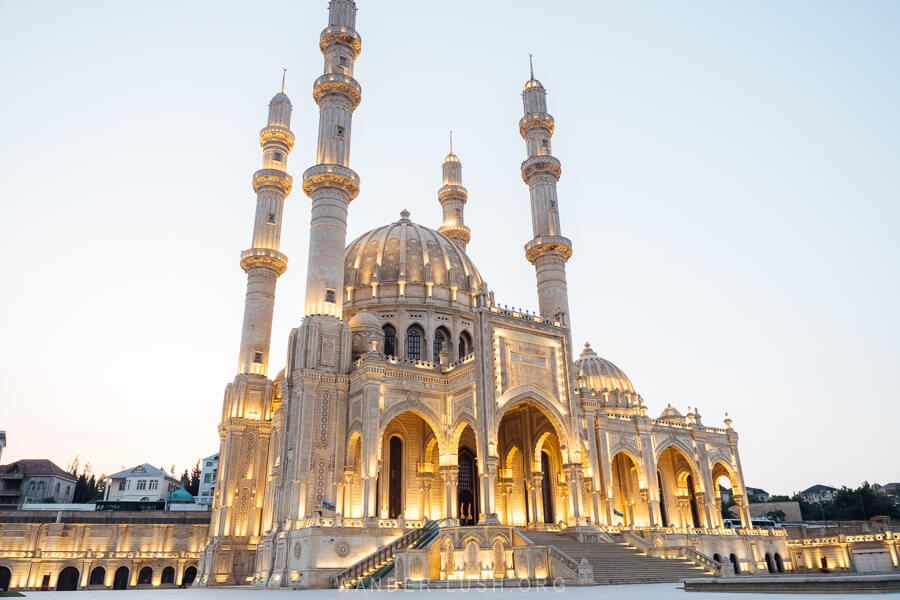
The Heydar Mosque.
Day 3: Day trip to Gobustan & the Absheron Peninsula
Spend your third and final day in Azerbaijan exploring the Absheron Peninsula and the Caspian Coastline beyond Baku.
This classic day trip itinerary covers the Gobustan mud volcanoes and petroglyphs, the Ateshgah Zoroastrian Temple and Yanardag, the famous ‘flaming hillside’.
If you ask me, the highlight is definitely the bubbling Gobustan mud volcanoes, which represent the highest concentration of mud geysers anywhere on earth. A guided walk through the nearby Gobustan State Historical and Cultural Reserve reveals some of the 6,000 examples of prehistoric rock art undercovered at the site.

Gobustan.
The Ateshgah Zoroastrian Temple has been restored and turned into a museum, and it is a great place to learn the basics of the ancient fire-worshipping religion. You might find Yanardag a little underwhelming, but the myth of a burning mountain lit by a careless shepherd is very unique.
On my last trip to Baku, I took this day tour which I booked through Viator. It includes lunch, all entrance fees, and all transportation.
When you return to the city in the evening, enjoy a traditional hammam treatment at Agha Mikayil before dinner.
Recommended reading: How to plan a Gobustan day trip

Ateshgah Temple.
Days 4-5: Quba & Khinaliq
On Day 4, start the journey north to Khinaliq, Azerbaijan’s highest village and newest UNESCO World Heritage Site. The 230-kilometre (143-mile) trip up from Baku takes around four hours by car or a little longer by marshrutka van/taxi, with a paved road making the last stretch a lot faster and more pleasant.
Note: In summer 2024 the road to Khinaliq sustained some damage. It should still be navigable in a sedan, but I recommend you check conditions locally before you set out.
Remember to bring cash with you as there are no ATMs in the village.
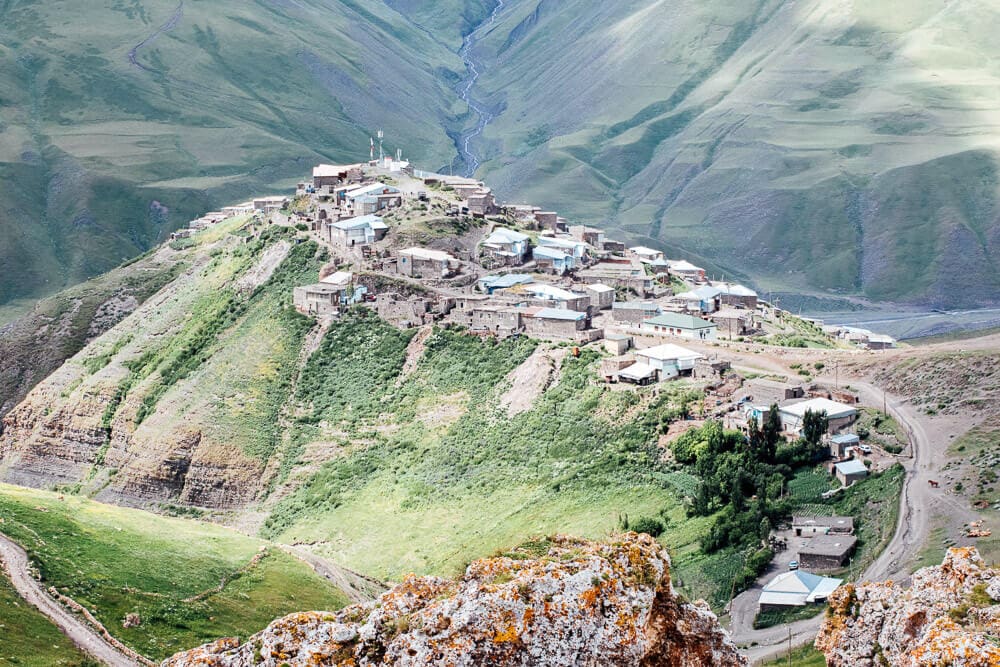
Khinaliq.
Arrive in the afternoon with enough time to visit the local mosque, wander through the two ethnographic museums, and venture up to the viewpoint before eating a home-cooked dinner at your homestay-style guesthouse. Khinaliq has 5,000 years of fascinating history behind it (and its own language) – so try to soak up as much of the culture as you can.
Primarily a hiking destination, Khinaliq is the starting point for some extremely scenic treks through the Greater Caucasus mountains. The most popular route, the Khinalig to Galakhudat Hike, takes around 7-8 hours (16 kilometres) return and is the perfect way to spend Day 5. You can modify this hike by continuing to Griz village (another 3 kilometres) then taking a taxi back to Khinaliq or Quba.
Leaving Khinaliq involves transiting back through Baku. For this reason, I recommend returning to the city in the late afternoon on Day 5 and spending the night in Baku.
First, take a taxi back to Quba (more details below) then connect to a Baku-bound van. The last marshrutka departs from Quba at 4.50pm, so if you’re any later than that, you will need to hop in a shared taxi. Expect to pay 15-20 AZN per person for a taxi or 6 AZN per person for the bus.
Recommended reading: What to expect when you visit Khinaliq

Lunch at a homestay in Khinaliq.
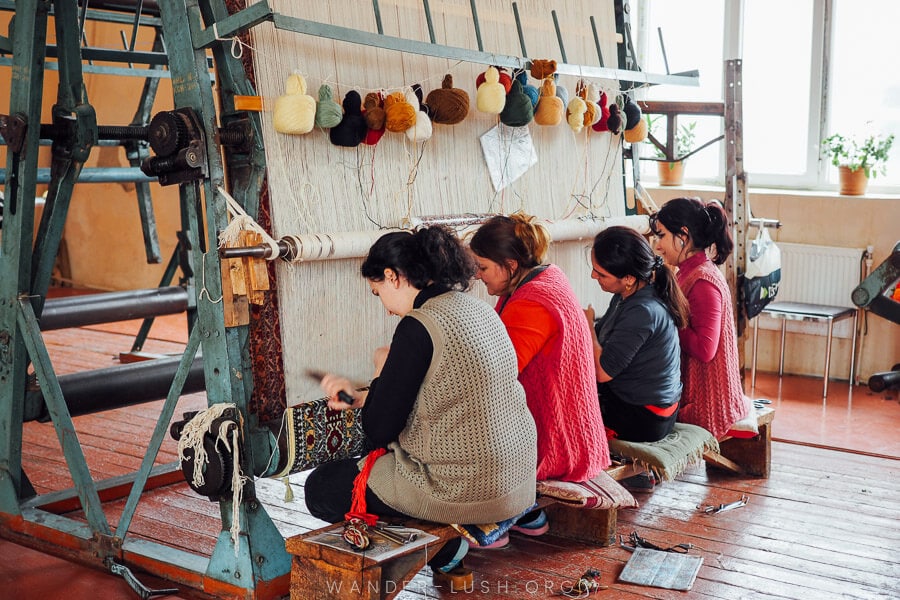
Carpet weaving in Quba.
How to get to Khinaliq from Baku
Minibuses to Quba depart frequently (every 20-40 minutes starting from 7.30am) from the International Bus Terminal in Baku. Travel time is around 3 hours and 20 minutes, and a ticket costs 6 AZN. Alternatively, a spot in a shared taxi should cost you 15-20 AZN.
Once in Quba, you will need to take a taxi the rest of the way. Drivers wait on the street adjacent to the Central Bus Station, around this point. It is best to arrive in the early afternoon, between midday and roughly 4pm. Expect to pay 15-20 AZN per person or 50-60 AZN for the whole car. Alternatively, pre-arrange a transfer through your guesthouse in Khinaliq.
If you prefer to visit Khinaliq as a day trip from Baku (and spend nights 4 and 5 in the city) this hiking tour with Bag Baku features an accompanied one-way trek from Galakhudat into Khinaliq and a home-cooked meal at one of the guesthouses.
Day 6: Shamakhi, Lahic, Tufandag & Gabala (overnight in Sheki)
Day 6 is a travel day, taking you from Baku on the tip of the Absheron Peninsula all the way to my favourite place in Azerbaijan, the Silk Road city of Sheki in the far north-west. I highly recommend you make the most of it by doing some sightseeing along the way.
Following the M4 Highway, there are several key stops to make between Baku and Sheki:
- The Diri Baba Mausoleum, a 15th-century mausoleum perched on a limestone cliff.
- The Juma Mosque in Shamakhi, the oldest mosque in the Caucasus (dated to 734 AD).
- Lahic, the famous coppersmith village (see my Lahic Guide for things to do when you’re there).
- Tufandag, Azerbaijan’s premier ski resort with a year-round gondola that you can ride for amazing mountain views.
- Gabala, a resort town with thermal springs and petroleum oil baths.
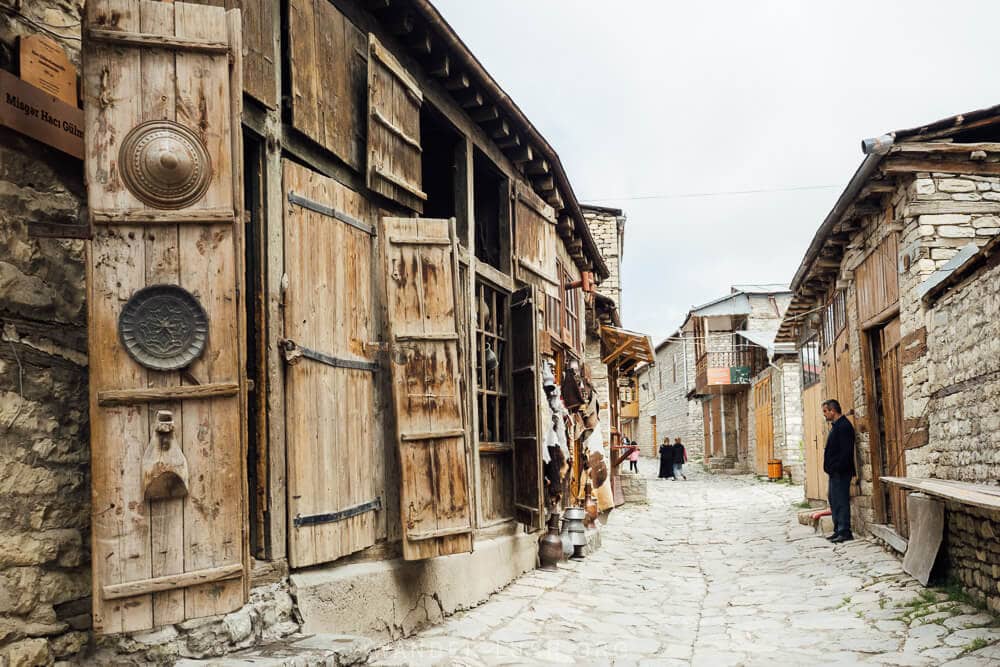
Lahic.

The Juma Mosque in Shamakhi.
How to get to Sheki from Baku via Shamakhi, Lahic, Tufandag & Gabala
There are two ways to do this trip: Book a one-way transfer tour with TES Tour (AKA Old City Tours) or hire your own car.
I recently visited Azerbaijan with my dad and we decided to hire a car and driver for 36 hours to travel from Baku to our accommodation in Sheki, stopping at all the points mentioned above along the way. It was efficient and affordable, and we lucked out by getting a great driver-guide.
If you are a confident driver, you can always rent your own car and replicate the itinerary. This would of course give you a bit more flexibility to stay longer in Lahic, for example, or to overnight somewhere different en route to Sheki. I recommend using the Local Rent website to find a rental car.
If you are content to skip the places along the way, you can travel directly from Baku to Sheki by bus. There are four daily departures plus a night bus. Tickets cost 13.39 AZN, and travel time is around 6.5 hours.
This will give you an additional full afternoon in Sheki, which you can easily fill (see below and Days 9-10 of the next itinerary for more suggestions for Sheki and the surrounding area).
Recommended reading: How to travel from Baku to Sheki
Day 7: Sheki
This itinerary saves the best for last. A city of caravanserais and silk workshops, Sheki is absolutely my favourite place in Azerbaijan – and one of my favourite places in the world.
If you opted for the transfer with Old City Tours, you will start the day with a visit to the Sheki Khan’s Palace (entrance is included in the tour price) and a short drive out to Kish for the Caucasian Albanian Temple.
Whilst in Kish, be sure to stop at Ilhama Tea House for a piece of fresh-baked lapali chorak, a Kish specialty bread filled with a sweet-sour paste made from ground walnuts, diced onions and cornelian cherry syrup, and a strong glass of black tea.

The Palace of the Sheki Khans.
If you are staying the night in Sheki, bid farewell to your driver and return to the Khan’s Palace (your ticket is good for the full day) ahead of the Khan’s Mosque, the lesser-visited Winter Palace, and the Upper Caravanserai. Pause at Halvaci Yehya to buy a slice of sugary-sweet Sheki halva, and at Kelaghayi Silk Scarf Shop to buy a special silk souvenir.
Spend the evening walking the magical streets of Sheki and feast on Azerbaijani plov at VIP Karvan Restaurant before retiring for the night.
Recommended reading: My ultimate guide to visiting Sheki

The Upper Caravanserai (Karvansaray Hotel) in Sheki.
Departing from Sheki
Old City Tours gives you the option to return to Baku with your driver, or to continue all the way to the Georgian border. I recommend you stay in Sheki for an additional afternoon and night before continuing the journey the following day.
It is possible to cross overland into Georgia via the Balakan-Matsimi land border. First, take a taxi from Sheki to the immigration point (around 40-60 AZN), the cross by foot (the process takes around 40 minutes, and you will need to present your Azerbaijan e-visa again.
In Georgia, you can pick up a local taxi to take you to Tbilisi (around 120 GEL) or stay closer to the border area and start the Georgia part of your trip in Kakheti Wine Region or Vashlovani National Park.
If you are flying out of Baku, return to the city from Sheki by marshrutka (vans depart every 30-60 minutes from the bus station), overnight sleeper train (details and tickets here), or taxi.

The Georgia-Azerbaijan border.
Extend your trip: More places to visit in Azerbaijan
Qax/Ilisu (add 1 day)

Ilisu.
From Sheki, you can quite easily press further towards the Greater Caucasus to Qax (Gakh) where there are some great hiking opportunities.
This is a multicultural corner of Azerbaijan, home to St George’s Church, the awe-inspiring Kurmukhi Church, and countless other towers and ruins associated with Caucasian Albanian, Georgian and Armenian heritage.
At the end of the valley, Ilisu was once the centre of a sultanate. The 16 km Ilisu-Gashgachay trail and the hike to Ilisu Waterfall both make for a nice day walk. For more ideas, check out this article I wrote for National Geographic Traveller about the four best hiking trails in Azerbaijan.
Nakhchivan (add 2-3 days)

Nakhchivan. Photo: Sefer azeri/Wikimedia (CC BY-SA 4.0).
Separated from the rest of Azerbaijan by southern Armenia, the NakhchivanAutonomous Republic is an adventurous addition to any itinerary, and especially suitable for travellers who are interested in hiking and history.
Internal flights to Nakhchivan from Baku are operated by Azerbaijan Airlines, with 10 departures per day. Flight time is 1 hour and 20 minutes and tickets cost 140 AZN return.
Spend one day in the city centre visiting Noah’s Mausoleum, the 18th-century Palace of Nakhchivan Khans, the Momine Khatun Mausoleum, and Yezidabad Castle. Get an early start the next morning to arrive at Alinja Castle before 10am. The climb to the top of the ‘Machu Picchu of the Caucasus’ takes the better part of two hours, and it’s best to start when there is still some shade. Explore the castle grounds, then hike up a little higher for a bird’s eye view.
The Tomb of Sheikh Khorasan and Ashab-i Kehf Cave are two more historical sites located close to Alinja Mountain. The best way to see all three is by hiring a driver for the day. Your accommodation can help with this – expect to pay around 50-60 AZN per car.
Lankaran (add 2-3 days)

Lankaran.
Located in the far-southern corner of Azerbaijan, just shy of the border with Iran, Lankaran is the country’s tea and fruit growing region. Here, the Caspian Coast meets the Talysh Mountains to produce rich soils and unique landscapes. Like Guria in Georgia, tea was cultivated here during the Soviet period, with the first bushes planted in 1932.
I visited Lankaran in spring 2023, and was impressed by how different this corner of Azerbaijan is compared to the rest of the country. I visited Nilado Green, a popular tea farm, and the Citrus Valley plantation, where there is a beautiful farm-to-table restaurant set amongst the fruit orchards. Tours and experiences can be organised direct or through Lankaran DMO (details here).
Lankaran is also known for its national parks and wetlands. Hike in Hirkan National Park, or go birding in the marshy Gizil-Agach State Reserve.
Buses to Lankaran set off from Baku’s International Bus Terminal throughout the day (10+ departures) between 7.30am and 6pm. Travel time to Lankaran is 2.5-3 hours, and the fare is 8.50 AZN.
Ganja (add 1-2 days)

Ganja.
Located in western Azerbaijan, Ganja is the country’s third-largest city. It is most often associated with the poet Nizami, who was born in Ganja in 1141. The Nizami Ganjavi Mausoleum is one of the city’s biggest attractions.
On the outskirts of Ganja, Imamzadeh Ibrahim is a complex of mosques and mausoleums decorated with blue tiles that is reminiscent of Islamic architecture in Uzbekistan. The archaeological site of Old Ganja is located nearby.
Two hours by road from the border, Ganja can be used as an alternative gateway into Georgia via the Red Bridge Customs Post. Onward transport to Tbilisi via Rustavi can be organised at the border.
To get to Ganja from Baku, you can either take a bus (6-6.5 hours; 13.29 AZN) or a local train (9 hours).
Azerbaijan essentials
Here are some of the websites and services I use for planning a trip to Azerbaijan and the Caucasus. Remember to check out my full list of travel resources for more tips.
FLIGHTS: Find affordable flights to Baku on Skyscanner.
VISAS: Use iVisa to check if you need a tourist visa for Azerbaijan and apply for an expedited visa online.
DOCUMENTATION: Use OneWayFly to obtain proof of onward travel/hotel reservation for your visa application.
TRAVEL INSURANCE: Insure your trip with HeyMondo, my preferred provider for single-trip and annual travel insurance (use my link for 5% off).
AIRPORT TRANSFER: Pre-book a private transfer from Baku Airport to your hotel.
RENTAL CAR: Use Local Rent to find an affordable rental from a local agent.
ACCOMMODATION: Find the best Azerbaijan hotel deals on Booking.com or book a Baku hostel.
SHORT ON TIME? Get to know Baku on this Old City walking tour, or join this panoramic night tour to see Baku in her best light.
ALI AND NINO: Pick up a copy of Ali and Nino, Azerbaijan’s national novel. I can guarantee that Kurban Said’s evocative descriptions of Baku will get you excited for your trip!
More Azerbaijan travel resources
- My Azerbaijan travel tips & latest guides
- All the best things to see and do in Baku, Azerbaijan’s capital city
- Baku Old City, what to see & do inside the old walls
- The Heydar Aliyev Center, my best photos & visitors’ tips
- 12 best day trips from Baku, where to go & how to get there
- How to take a day trip from Baku to Gobustan for the mud volcanoes
- My guide to Sheki, Azerbaijan’s most beautiful city
- My tips for visiting the Khan’s Palace in Sheki, a UNESCO World Heritage Site
- How to spend the night in a Silk Road caravanserai in Azerbaijan
- How to travel from Baku to Sheki
- My guide to Khinaliq, trekking & homestays
- My guide to Lahic, traditional crafts & ancient architecture
- My guide to Quba, Azerbaijani carpet weaving
- How to travel to/from Baku and Georgia by overnight train
- All about the BTAK railway from Baku to Kars via Tbilisi
- My best photos of Azerbaijan to inspire your travels
- The ultimate Caucasus itinerary for Georgia, Armenia & Azerbaijan
- Efficient 10-14 day Azerbaijan Georgia itinerary for overland travel
- Tips for travelling around Azerbaijan by bus